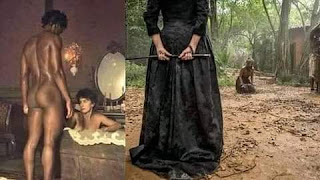A SOIL THAT THIRSTS FOR BLOOD
A SOIL THAT THIRSTS FOR BLOOD
A popular theory is that Charles Walton’s murder was some form of ritual sacrifice – “the ghastly climax of a pagan rite,” according to the Chief Inspector. [28] Margaret Murray, a professor from University College in London who had written extensively on the history of European witchcraft, took a great interest in the Walton case. She claimed that the murder was likely a ritual act, performed for the purpose of replenishing the soil with the old man’s blood. “The belief is,” according to Murray, “that if life is taken out of the ground […] it must be replaced by a blood sacrifice.” [29]
Not much is known about “the old ways” as they were practiced during Iron Age Britain. What little information there is has been pieced together from the accounts of Roman historians and various archaeological discoveries – both of which point to the importance of ritual sacrifice within the ancient Celtic magico-religious system.
Sacrifice was the means by which the balance of nature was maintained, with offerings made to the governing divine forces in exchange for their blessings. Most consisted of animals, food, wine, incense, weapons, or jewelry. However, the ritual murder of humans was not unusual. It was an extraordinary form of sacrifice made during particularly critical times; to avert a famine or epidemic, provide victory before a battle, promote fertility, or guarantee a successful harvest. [30]
Victims would be selected from across a wide spectrum of candidates that included criminals, kings, menopausal women, adolescents, rival clan chiefs, social outcasts, and witches. [31] Witches in particular are thought to have been a sacrificial favorite. As it was widely believed that they possessed the power to disrupt or manipulate the natural order, a witch provided the ideal scapegoat offering to appease the gods and restore essential balance.
Celtic Druids are most infamously known for burning people in large wicker effigies. But they also strangled, drowned, poisoned, stoned, beheaded, dismembered, and buried them alive. The sacrificial act could vary, with different means of dispatching used for different ceremonial purposes – and sometimes the gods called for a bloodbath. One particularly gruesome Druidic ritual shares certain similarities with the Walton murder. Known as “the threefold death,” multiple killing methods (such as strangulation, head injuries, and throat-cutting) would be used in an act of ritual overkill to either appease multiple gods or ensure maximum bloodshed. [32]
As an agriculturally-based society, blood was particularly important to the Celts when it came to maintaining a healthy crop cycle. During the winter months, when the land had frosted over and the sun hung low in the sky, it was believed that the world had reached the end of its life-cycle. In order to “reawaken the earth” and usher in a new season of rebirth and revitalization, the soil needed to be symbolically replenished with life-giving blood. [33]
If the Walton murder was indeed some crude form of human sacrifice, the date when it took place may hold some significance. He was killed on February 14th. Going by the old (pre-Gregorian) calendar, which was twelve days behind, this date would correspond with the Celtic Midwinter festival of Imbolc. As a celebration of new life, Imbolc rituals centered around ensuring a successful growing season and the health and fertility of local livestock. [34] If rumors are to be believed, Walton was to blame for the failure of the previous year’s harvest and the unexplained death of a cow. To break the hex he was believed to have placed over the community and restore a sense of natural order, it may be no coincidence that his blood was spilled on this day.
The use of a pitchfork may further reinforce the ‘ritual murder theory,’ and is also not without precedent in the region. Following the Anglo-Saxon settlement of the area in the fifth-century, new traditions of witch-hunting would take root. Differing from later medieval Christian beliefs, the Anglo-Saxon concept of witchcraft centered on specific acts of (perceived) sorcery, rather than some broader diabolical conspiracy. The practice itself was not considered a crime; however, if it were used for criminal purposes, the punishment could be harsh. One crude investigative method used was called stacung (“sticking” or “staking”), where the bodies of the accused would be pierced with iron spikes, pins, or large thorns. If the wounds festered and turned black, it was considered proof that they were practitioners of black magic. [35]
Similar to the original stacung practice is a more recent (beginning in the 1500s) Cotswold hill-country belief that a witch’s powers could be drained through “blooding” – that is, to draw blood by a non-lethal stab wound (“be it but a pin’s prick”). William Shakespeare, the area’s most famous native son, even made reference to the practice in his play Henry VI, Part I (“Blood will I draw on thee, thou art a witch.”). [36] A number of blood-letting assaults against suspected witches would take place in the Warwickshire village of Tysoe in the later nineteenth-century. In one such attack, an elderly woman was seized by area residents, who used a corking pin to puncture her hand in an attempt “to nullify the effects of the evil eye she had cast upon them.” [37]





Comments
Post a Comment